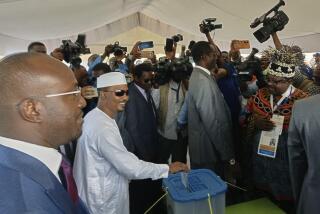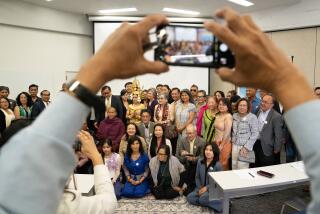Cambodian Rebels Shift Stance, Turn Up to Vote : Asia: The Khmer Rouge, with no candidates running, had spurned the election and threatened to disrupt it.
- Share via
THMAR POUK, Cambodia — A blue pickup truck pulled up in front of a polling station guarded by Dutch marines here Thursday, and more than 20 peasants climbed out, eager to cast ballots in Cambodia’s national elections.
“Look at those sandals made of old tires and the way they are dressed,” said an Australian policeman, Peter Baldwin, who was helping to guard the station. “That’s a clear sign that these people are Khmer Rouge.”
Despite threats to disrupt the election, the Khmer Rouge has not only failed to launch widespread attacks against U.N. officials who are conducting the polls but in a remarkable about-face, the Maoist guerrilla group seems in many cases to be encouraging its own people to vote.
On Thursday, the fifth day of the six-day election, a group of gunmen believed to be Khmer Rouge fired on a mobile voting station in Siem Reap province in northwestern Cambodia. Four people, including a Bangladeshi peacekeeper, were wounded, and the station was closed. But elsewhere, including Khmer Rouge-held territory, voting was generally peaceful.
Here in Thmar Pouk, a district town 170 miles northwest of Phnom Penh, trucks from remote villages have been arriving at regular intervals, carrying men and women from Khmer Rouge areas, which are off limits to U.N. officials.
The number of voters from such remote towns is so great that Kiran Baset, a district election officer from Nepal, said they have swollen the turnout here to a point that the number of ballots cast exceeds 100% of the registered voters in the district--thanks to a rule that allows voters registered in one district to vote anywhere. Of 15,000 votes cast here so far, Baset guessed that a quarter were deposited by citizens from Khmer Rouge-controlled areas.
At a polling station in nearby Banteay Chhmar, Khmer Rouge guerrillas appeared outside, dressed in battle uniform and carrying weapons, Baldwin said. The guerrillas laid down their arms, took off their uniform shirts and voted in their T-shirts.
This district near the Thai border lies in the “liberated zone,” meaning it is in territory held by the three guerrilla armies that fought the Phnom Penh administration before an October, 1991, peace agreement. Many of the towns and villages are mixed, with Khmer Rouge and followers of two non-Communist factions living alongside each other in what passes for harmony.
Thmar Pouk is a kind of Cambodian “Dodge City,” where armed soldiers of every description walk the streets, cradling AK-47 assault rifles in their arms and packing rockets on their backs.
Unarmed Khmer Rouge soldiers shop in the market in Thmar Pouk alongside elements of non-Communist factions, Australian police and Dutch soldiers. Pham Su, a Khmer Rouge general, keeps a house near the market.
There is still an element of mystery about why the Khmer Rouge, which ruled the country in the 1970s and caused the deaths of more than 1 million Cambodians, has apparently changed its attitude toward the elections so completely.
Maj. Oscar Smith, commander of the Royal Dutch Marine battalion here, said a Khmer Rouge general named Dal Sairn turned up at a polling station Monday and said the guerrilla group no longer had any interest in disrupting the voting. An officer accompanying him then went in and voted.
“They don’t do anything on their own authority,” Smith said. “It was a strategic decision. If the intentions were there to disrupt the elections, it means everyone knew of the strategic change from the first day on.”
Only a week earlier, 70 heavily armed Khmer Rouge soldiers had driven into Thmar Pouk to demonstrate during a visit by the chiefs of the Australian and U.S. missions in Phnom Penh. They had also sent messages to the Dutch, warning that they would be killed if they ventured out of their compound.
The incidents caused a general exodus of civilian U.N. personnel, meaning that the number of polling stations had to be reduced from 23 to only seven. Police and military forces were pressed into service as polling station observers.
However, it appeared that the Khmer Rouge had taken a strategic decision to forgo violence and support the royalist party known as FUNCINPEC in an effort to win a place in the new government.
The Khmer Rouge has no candidates among the 20 competing parties and has pinned its hopes on being included in a government of “national reconciliation.”
More to Read
Sign up for Essential California
The most important California stories and recommendations in your inbox every morning.
You may occasionally receive promotional content from the Los Angeles Times.










